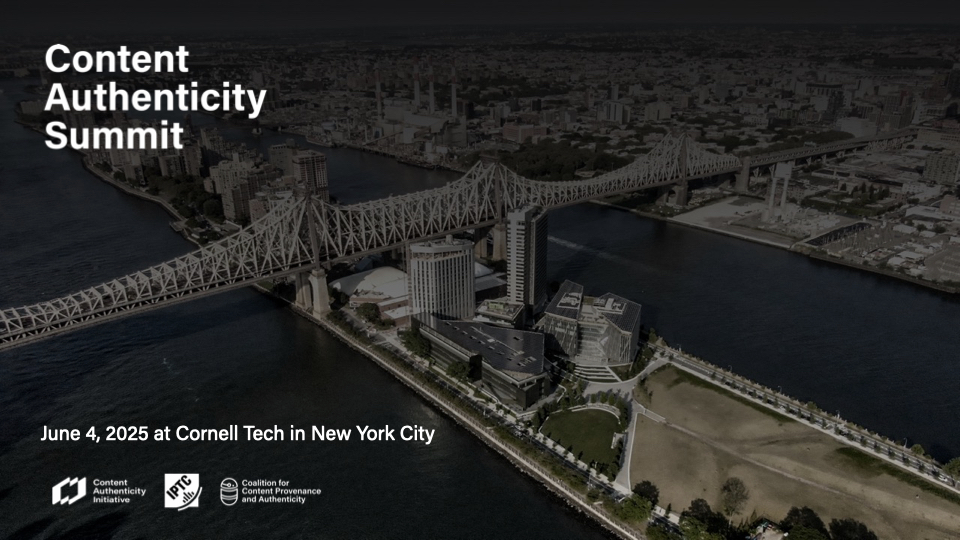Categories
Archives
IPTC member France Télévisions has started signing its daily news broadcasts using C2PA and FranceTV’s C2PA certificate, which is on the IPTC Origin Verified News Publisher List.
This makes France TV the first news provider in the world to routinely sign its daily news output with a C2PA certificate.
The work won FranceTV the EBU Technology & Innovation Award this year.
IPTC has assisted FranceTV in this work and continues to work with FranceTV along with other broadcasters and publishers on signing their content using the C2PA specification.
A specific page Retrouvez nos JT certifiés (“Find our certified news programmes”) is available on FranceTV’s site franceinfo.fr, where the latest 1pm and 8pm news programmes are published containing a C2PA signature. The page Pour vous informer en toute sécurité contains more information (in French) about FranceTV’s work on transparency and authenticity.
We congratulate FranceTV for their work and look forward to further collaboration in 2026 and beyond.
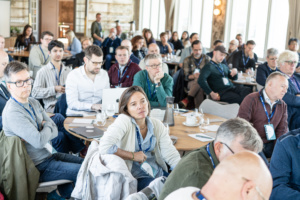
The Media Provenance Summit brought together leading experts, journalists and technologists from across the globe to Mount Fløyen in Bergen, Norway, to address some of the most pressing challenges facing news media today.
Hosted by Media Cluster Norway, and organised together with the BBC, the EBU and IPTC, the full-day summit on September 23 convened participants from major news organisations, technology providers and international standards bodies to advance the implementation of the C2PA content provenance standard, also known as Content Credentials, in real-world newsroom workflows. The ultimate aim is to strengthen the signal of authentic news media content in a time where it is challenged by generative AI.
“We need to work together to tackle the big problems that the news media industry is facing, and we are very grateful for everyone who came together here in Bergen to work on solutions. I believe we made important progress,” said Helge O. Svela, CEO of Media Cluster Norway.
The program focused on three critical questions:
- How to preserve C2PA information throughout editorial workflows when not all tools yet support the technology.
- When to sign content as it moves through the workflow at device level, organisational level, or both.
- How to handle confidentiality and privacy issues, including the protection of sources and sensitive material.
“We were very happy to see a focus on real solutions, with some great ideas and tangible next steps,” said IPTC’s Managing Director, Brendan Quinn. “With participants from across the media ecosystem, it was exciting to see vendors, publishers, broadcasters and service providers working together to address issues in practically applying C2PA to media
workflows in today’s newsrooms.”
Speakers included Charlie Halford (BBC), Andy Parsons (CAI/Adobe), François-Xavier Marit (AFP), Kenneth Warmuth (WDR), Lucille Verbaere (EBU), Marcos Armstrong and Sébastien Testeau (CBC/Radio-Canada), and Mohamed Badr Taddist (EBU).
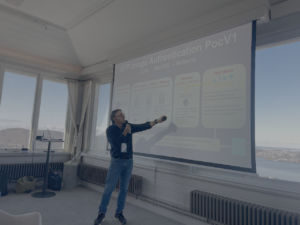
“The BBC welcomes this focus on protecting access to trustworthy news. We are proud to have been founder members of the media provenance work carried out under the auspices of C2PA and we are delighted to see it moving forward with such strong industry support,” said Laura Ellis, Head of Technology Forecasting at BBC Research.
Participants travelled to participate in the summit from as far away as Japan, Australia, the US and Canada.
“We’re pleased to collectively have taken a few hurdles on the way to enabling a broader adoption of Content Provenance and Authenticity”, said Hans Hoffmann, Deputy Director at EBU Technology and Innovation Department. “The definition of common practices for signing content in workflows, retrieving provenance information thanks to soft binding, and better safeguards for the privacy of sources address important challenges. Public service media are committed to fight disinformation and improve transparency, and EBU members were well represented in Bergen. The broad participation from across the industry and globe
smooths the path towards adoption. Thanks to Media Cluster Norway for hosting the event!”
The summit emphasised moving from problem analysis to solution exploration. Through structured sessions, participants defined key blockers, sketched practical solutions and developed action plans aimed at strengthening trust in digital media worldwide.
About the Summit
The Media Provenance Summit was organised jointly by Media Cluster Norway, the EBU, the BBC and IPTC, and made possible with the support of Agenda Vestlandet.
For more information, please contact: helge@medieklyngen.no
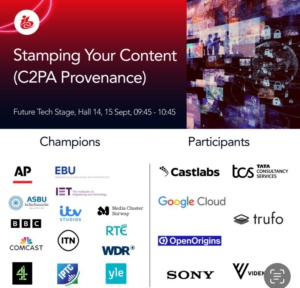 The IPTC has joined the BBC (UK), YLE (Finland), RTÉ (Ireland), ITV (UK), ITN (UK), EBU (Europe), AP (USA/Global), Comcast (USA/Global), ASBU (Africa and Middle East), Channel 4 (UK) and the IET (UK) as a “champion” in the Stamping Your Content project, run by the IBC Accelerator as part of this year’s IBC Conference in Amsterdam.
The IPTC has joined the BBC (UK), YLE (Finland), RTÉ (Ireland), ITV (UK), ITN (UK), EBU (Europe), AP (USA/Global), Comcast (USA/Global), ASBU (Africa and Middle East), Channel 4 (UK) and the IET (UK) as a “champion” in the Stamping Your Content project, run by the IBC Accelerator as part of this year’s IBC Conference in Amsterdam.
These “Champions” represent the content creator side of the equation. The project also includes “participants” from the vendor and integrator community: CastLabs, TCS, Videntifier, Media Cluster Norway, Open Origins, Sony, Google Cloud and Trufo.
This project aims to develop open-source tools that enable organisations to integrate Content Credentials (C2PA) into their workflows, allowing them to sign and verify media provenance. As interest in authenticating digital content grows, broadcasters and news organisations require practical solutions to assert source integrity and publisher credibility. However, implementing Content Credentials remains complex, creating barriers to adoption. This project seeks to lower the entry threshold, making it easier for organisations to embed provenance metadata at the point of publication and verify credentials on digital platforms.
The initiative has created a proof-of-concept open source ‘stamping’ tool that links to a company’s authorisation certificate, inserting C2PA metadata into video content at the time of publishing. Additionally, a complementary open-source plug-in is being developed to decode and verify these credentials, ensuring compliance with C2PA standards. By providing these tools, the project enables media organisations to assert content authenticity, helping to combat misinformation and reinforce trust in digital media.
This work builds upon the “Designing Your Weapons in the Fight Against Disinformation” initiative at last year’s IBC Accelerator, which mapped the landscape of digital misinformation. The current phase focuses on practical implementation, ensuring that organisations can start integrating authentication measures in real-world workflows. By fostering an open and standardised approach, the project supports the broader media ecosystem in adopting content provenance solutions that enhance transparency and trustworthiness.
Attend the project’s panel presentation session at the International Broadcasting Convention, IBC2025 in Amsterdam on Monday, Sept 15 at 09:45 – 10:45.
The speakers on the panel on Monday September 15 are all from IPTC member organisations:
- Henrik Cox, Solutions Architect – OpenOrigins
- Judy Parnall, Principal Technologist, BBC Research & Development – BBC
- Mohamed Badr Taddist, Cybersecurity Master graduate, content provenance and authenticity – European Broadcasting Union (EBU)
- Tim Forrest, Head of Content Distribution and Commercial Innovation – ITN
See more detail on the IBC Show site.
Many of the participating organisations are also IPTC members, so the work started in the project will continue after IBC through the IPTC Media Provenance Committee and its Working Groups.
We are already planning to carry this work forward at the next Media Provenance Summit which will be held later in September in Bergen, Norway.
Google has announced the launch of its latest phone in the Pixel series, including support for IPTC Digital Source Type in its industry-leading C2PA implementation.
Many existing C2PA implementations focus on signalling AI-generated content, adding the IPTC Digital Source Type of “Generated by AI” to content that has been created by a trained model.
Google’s implementation in the new Pixel 10 phone differs by adding a Digital Source Type to every image created using the phone, using the “computational capture” Digital Source Type to denote photos taken by the phone’s camera. In addition, images edited using the phone’s AI manipulation tools show the “Edited using Generative AI” value in the Digital Source Type field.
Note that the Digital Source Type information is added using the “C2PA Actions” assertion in the C2PA manifest; unfortunately it is not yet added to the regular IPTC metadata section in the XMP metadata packet. So it can only be read by C2PA-compatible tools.
Background: what is “Computational Capture”?
The IPTC added Computational Capture as a new term in the Digital Source Type vocabulary in September 2024. It represents a “digital capture” that does involve some extra work using an algorithm, as opposed to simply recording the encoded sample hitting the phone sensor, as with simple digital cameras.
For example, a modern smartphone doesn’t simply take one photo when you press the shutter button. Usually the phone captures several images from the phone sensor using different exposure levels and then an algorithm merges them together to create a visually improved image.
This of course is very different from a photo that was created by AI or even one that was edited by AI at a human’s instruction, so we wanted to be able to capture this use case. Therefore we introduced the term “computational capture”.
For more information and examples, see the Digital Source Type guidance in the IPTC Photo Metadata User Guide.
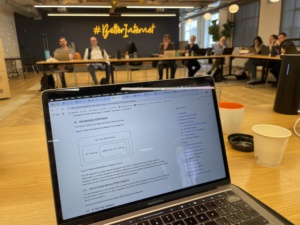
The IPTC participated in a “design team” workshop for the Internet Engineering Task Force (IETF)’s AI Preferences Working Group. Brendan Quinn, IPTC Managing Director attended the workshop in London along with representatives from Mozilla, Google, Microsoft, Cloudflare, Anthropic, Meta, Adobe, Common Crawl and more.
As per the group’s charter, “The AI Preferences Working Group will standardize building blocks that allow for the expression of preferences about how content is collected and processed for Artificial Intelligence (AI) model development, deployment, and use.” The intent is that this will take the form of an extension to the commonly-used Robots Exclusion Protocol (RFC9309). This document defines the way that web crawlers should interact with websites.
The idea is that the Robots Exclusion Protocol would specify how website owners would like content to be collected, and the AI Preferences specification defines the statements that rights-holders can use to express how they would like their content to be used.
The Design Team is discussing and iterating the group’s draft documents: the Vocabulary for Expressing AI Usage Preferences and the “attachment” definition document, Indicating Preferences Regarding Content Usage. The results of the discussions will be taken to the IETF plenary meeting in Madrid next week, and
Discussions have been wide-ranging and include use cases for varying options of opt-in and opt-out, the ability to opt out of generative AI training but to allow search engine indexing, and the difference between preferences for training and preferences for how content can be used at inference time (also known as prompt time or query time, such as RAG or “grounding” use cases) and the varying mechanisms for attaching these preferences to content, i.e. a website’s robots.txt file, HTTP headers and embedded metadata.
The IPTC has already been looking at this area and defined a data mining usage vocabulary in conjunction with the PLUS Coalition in 2023. There is a possibility that our work will change to reflect the IETF agreed vocabulary.
The work also relates to IPTC’s recently-published guidance for publishers on opting out of Generative AI training. Hopefully we will be able to publish a much simpler version of this guidance in the future because of the work from the IETF.
The International Press Telecommunications Council (IPTC) is proud to co-host the 2025 Content Authenticity Summit, along with the Coalition for Content Provenance and Authenticity (C2PA) and the Content Authenticity Initiative (CAI). The event will be held tomorrow, Wednesday 4 June at the Cornell University campus on Roosevelt Island, New York City.
The Content Authenticity Summit will convene over 200 of the world’s foremost experts on digital content provenance including implementers, creators, and policymakers for a one-day series of presentations, panels, breakout sessions, and hands-on demonstrations to highlight the latest developments in this essential and fast-moving space.
The Summit, presented by the Content Authenticity Initiative, the Coalition for Content Provenance and Authenticity, and the International Press Telecommunications Council, will highlight current opportunities and challenges focused on driving broad awareness and adoption of Content Credentials.

Brendan Quinn, Managing Director of IPTC, will be hosting two workshops at the Content Authenticity Summit.
Many other IPTC members will also be represented:
- Adobe will have many representatives at the event, including Andy Parsons, Eric Scouten, Pia Blumenthal and Leonard Rosenthol
- Bruce MacCormack of CBC / Radio Canada, Chair of the Media Provenance Committee, will speak about C2PA adoption in the news media
- Helge O. Svela, CEO of Media Cluster Norway will co-host workshops on C2PA in the news industry.
- AFP and IMATAG will present a case study on their project to digitally sign content
- Charlie Halford of the BBC will co-host the workshop on C2PA metadata in the news industry
- Will Kreth of HAND Identity will be speaking about how provenance protects the identities of athletes and entertainers
- Sherif Hanna of Google will be speaking about the forthcoming C2PA Conformance process.
Other speakers include representatives from Meta, LinkedIn, OpenAI, Partnership on AI and Nikon.
We will report on the event later this week. If you’re attending, come and say hello to our members and to IPTC Managing Director Brendan Quinn.

The IPTC has provided input to a submission made by the Global Media Registry to the European Commission’s European Democracy Shield consultation.
The GMR submission discusses the value of organisational identification:
The Importance of Identification and Attribution
Unambiguous attribution is in the best interest of anyone doing honest business. It is also a key requirement for consumer protection.
Not surprisingly, to “Know your Supplier” (KYS) and to “Know your Customer” (KYC) have become essential principles of securing supply chains in almost every industry. In turn, bad actors can capitalize on the absence of clear attribution by faking the identity of brands, vendors or buyers to deceit and to cheat – and to get away with it.
Exactly this happens currently in the field of disinformation, as far as the phenomenon of so-called “Doppelgangers” is concerned. It refers to anonymous imposters falsely claiming to be – among others – DER SPIEGEL, Le Monde, CBC/Radio-Canada, the BBC or CNN, to publish content online that would never appear in either of those highly acclaimed news outlets.
The C2PA specification, and IPTC’s efforts to implement it in the media industry through the IPTC Origin Verified News Publishers List, are recommended as critical means to identify media organisations in a way that is tamper-evident and traceable. Other means of identifying organisations mentioned in the paper include the Legal Entity Identifier (LEI), Global Media ID (which is promoted by Global Media Registry) and International Standard Content Code (ISCC).
The paper concludes:
As a response to the World Financial Crisis 2008/09, the Financial Stability Board of the G20 established a global system of legal entity identifiers, and eventually GLEIF, in order to fix a number of apparent vulnerabilities of the financial sector.
The European Commission should follow this example when designing the ‘Democracy Shield’ and support a global system of identification to fix a number of equally visible vulnerabilities of our shared information space.
Global Media Registry, a liaison partner of the IPTC, is one of the organisations behind the forthcoming ISO specification for a Global Media Identifier (GMI). The specification is currently going through the ISO standardisation process as ISO IWA 44:2025. The IPTC and some IPTC member organisations have participated in the drafting process.
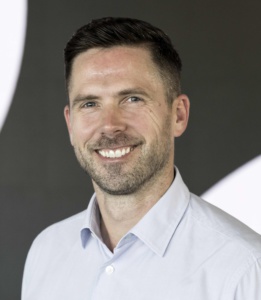
The following is a guest post from Helge O. Svela, CEO of Media Cluster Norway. Media Cluster Norway joined the IPTC as Associate Members of IPTC in 2024 and Helge is the lead of the Provenance Best Practices and Implementation Working Group, where news publishers work together to talk about their progress in implementing C2PA and the IPTC Verified News Publisher programme within their organisations.
In this article, Helge introduces Project Reynir, an initiative to bring secure media signing technology to the Norwegian media industry.
The journalistic institution must rethink how it develops and applies technology if society is to stand a chance against the deluge of fake images and video from generative AI. Never before in human history has it been easier to produce realistic, but fake, images and video, and spread them around the world. The rapid technological development of generative artificial intelligence has turbocharged the engines of disinformation, and caught both society and journalism off-guard. Never have we been more vulnerable.
Disinformation is destabilising our democracies, and spreading erroneous information. This potentially has severe consequences for both democratic processes and for the public in the face of natural disasters and other crises. The first round of the Romanian elections in 2024 was annulled due to what was dubbed an “algorithmic invasion” of social media disinformation. In the aftermath of the earthquake in Myanmar in March, AI-generated videos of the devastating destruction shared by so called “engagement farmers”, likely with financial motives, got millions of views on social media.
Generative AI has given humanity the ability to create realistic videos and images simply by typing a few words into a website. However, these tools also quickly became a part of the arsenal for enemies of democracy. As a result, disinformation is becoming more prevalent, appearing more professional and costing almost nothing to produce. Generative AI is an industrial revolution also for the troll factories in Russia and others who seek to manipulate our perception of the world and sow doubt about what is true.
This is not a media problem. It is a democratic problem, and a dangerous one at that. Disinformation created by troll factories and generative artificial intelligence and spread by bots pose an immediate threat to our democracies. We might end up doubting absolutely everything. When anyone can claim anything is generated and fake, the liars come out on top. This could destroy the foundation of our democracies: trust in each other and in our institutions. One thing is current news, another is history. Imagine a dictator using fake historical footage of a hunger catastrophe in order to justify an ethnic cleansing of a minority. An internet flooded with claims and visual “proof” of what happened in the past, all of which looks authentic. As a result of generative AI this is no longer just a dystopian science fiction scenario. It is a real possibility. Never before have we needed editorial media more. However, the signal strength of editorial media risks being drowned out by an ever growing cacophony of junk content and disinformation.
Project Reynir is our response to the threat Generative AI poses. Because Generative AI makes it so easy to fake both content and sender, editorial media are under threat on two fronts. In Project Reynir, we aim to solve this problem using technical solutions.
The goal is to create something that makes it easier for ordinary people to distinguish between what is fake and what is real. By using cryptographically secured images and video, based on the open C2PA specification, it is possible for both newsrooms and regular media users to be confident that the images we are seeing have not been tampered with on their journey from the photographer’s lens to the mobile screen. Moreover, using the same technology, authenticity markers can be added to the images and videos from news publishers when they post stories on social media and other third party platforms. Thus guaranteeing that content that appears to be the BBC and AFP actually is from these news organisations and not someone impersonating them. If we succeed, we will be a significant step closer to solving the problem of artificially created noise for our present moment. Project Reynir unites newsrooms, media technology companies and academic researchers in the fight against disinformation. Our goal is an 80 percent adoption in the Norwegian news ecosystem, and to serve as a beacon of best practices for the rest of the world of news.
We believe that time is critical, and that all good forces now must unite. The technological development has moved rapidly in the last few years, and the adoption of technology has sometimes been irresponsible. If our democracies are to stand firm in the face of the disinformation tsunami we are facing, quality journalism must be empowered. Only then can we enable citizens to make informed choices free of manipulation and interference, in an environment where facts can be easily distinguished from lies. We call for the democratic governments of the world to invest in innovation in the news media space. The time for responsible tech innovation, made with resilient democracies in mind, is now.
This article was originally published in the report Seeking Truth, Ensuring Quality: Journalistic Weapons in the Age of Disinformation, published by the University of Bergen in collaboration with Media Cluster Norway, as a part of the Journalistic Weapons conference organised in Brussels on April 28 2025. The full report, including articles from Faktisk, the European Federation of Journalists, London School of Economics, the Center for Investigative Journalism Norway and others, is available at https://www.uib.no/sites/w3.uib.no/files/attachments/publication_seeking_truth_ensuring_quality.pdf.
Broadcast and entertainment companies including Disney, Sony Pictures, Gracenote, Sinclair, Amazon MGM heard from the IPTC’s Pam Fisher this week at the 2025 EIDR Annual Participant Meeting.
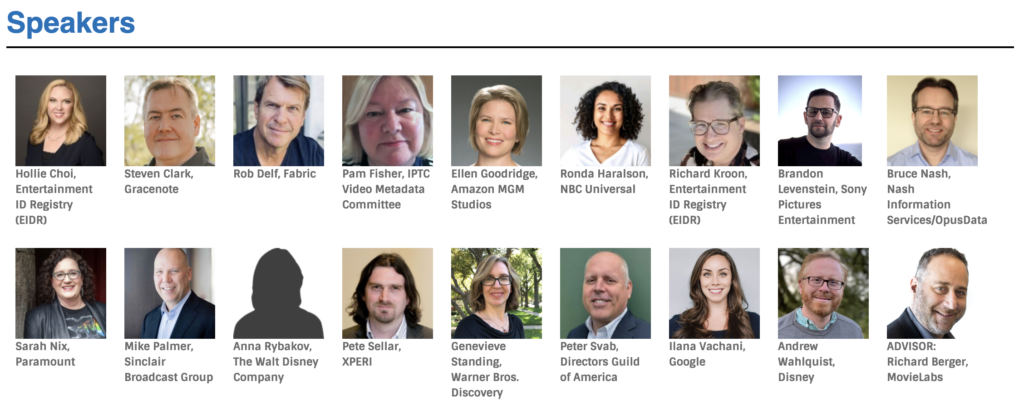
Pam is Lead of the IPTC Video Metadata Working Group, maintainers of the IPTC Video Metadata Hub standard. Pam spoke about IPTC’s work in video metadata and also our efforts in publisher provenance and credibility, particularly the work of the IPTC Media Provenance Committee.
The IPTC Verified News Publishers List is of particular interest to EIDR members who are keen to sign their content and ensure provenance and authenticity, similarly to news publishers. Pam talked gave a status update on the Verified News Publishers List, telling attendees that we now have between 10 and 20 publishers either with certificates or in the process of obtaining certificates.
Pam’s message to EIDR members, and the entertainment media industry in general, was to be patient: media provenance using C2PA is worth supporting, and broad adoption will become feasible over the next 6 to 18 months. The IPTC is figuring out a way forward using the news media industry as a test case. The goal is that once we have a system that works well in the news industry, we will be able to scale up to other types of media providers and publishers.
For more information on IPTC’s Media Provenance work or the Verified News Publisher List, please contact IPTC.
At the 2024 IPTC Photo Metadata Conference, James Lockman of Adobe’s Digital Media Services division demonstrated the Custom Metadata Panel, a tool that allows users to create their own user interface for editing sets of metadata fields. Since that time, the IPTC has worked with James and his team to make the tool even more useful, supporting the full set of IPTC properties and even enabling IPTC Photo Metadata as the default view in the tool.

The plugin can be installed from the Adobe Exchange plugin directory, and more information is available on the plugin’s GitHub repository, in particular the repository’s wiki pages.
For guidance on how to use the Custom Metadata Panel for editing IPTC metadata specifically, the IPTC Photo Metadata Working Group has created both a guide to installing the Custom Metadata Panel and a user guide for editing IPTC Photo Metadata using the Adobe Custom Metadata Panel. Together, the guidance pages explain how to install the tool, how to set it up for editing IPTC metadata, and some specific advice for editing particular types of metadata using the tool.
Support for both photo and video metadata
The Custom Metadata Panel also supports IPTC’s equivalent standard for video content, IPTC Video Metadata Hub. We will add guidance in the future for how it can be used to edit Video Metadata Hub metadata from within Adobe Premiere Pro.
The IPTC thanks James and his team for their work on the panel and for enhancing it so well over the past 12 months to turn it into a real power tool for media managers who want the full power of IPTC Photo Metadata at their fingertips.
Hands-on metadata workshop in Juan les Pins, France in May 2025
IPTC Managing Director Brendan Quinn will run a workshop on Wednesday 14th May showing users how to activate the plugin and how to use it to edit metadata for various purposes. This workshop will take place as part of the IPTC Day at CEPIC 2025, and so will be accessible to attendees of CEPIC 2025 and of the IPTC 2025 Spring Meeting.
Categories
Archives
- December 2025
- November 2025
- October 2025
- September 2025
- August 2025
- July 2025
- June 2025
- May 2025
- April 2025
- March 2025
- February 2025
- January 2025
- December 2024
- November 2024
- October 2024
- September 2024
- August 2024
- July 2024
- June 2024
- May 2024
- April 2024
- March 2024
- February 2024
- December 2023
- November 2023
- October 2023
- September 2023
- August 2023
- July 2023
- June 2023
- May 2023
- March 2023
- February 2023
- January 2023
- December 2022
- November 2022
- October 2022
- September 2022
- August 2022
- July 2022
- June 2022
- May 2022
- April 2022
- March 2022
- February 2022
- January 2022
- December 2021
- November 2021
- October 2021
- September 2021
- August 2021
- July 2021
- June 2021
- May 2021
- April 2021
- February 2021
- December 2020
- November 2020
- October 2020
- September 2020
- August 2020
- July 2020
- June 2020
- May 2020
- April 2020
- March 2020
- February 2020
- December 2019
- November 2019
- October 2019
- September 2019
- July 2019
- June 2019
- May 2019
- April 2019
- February 2019
- November 2018
- October 2018
- September 2018
- August 2018
- July 2018
- June 2018
- May 2018
- April 2018
- March 2018
- January 2018
- November 2017
- October 2017
- September 2017
- August 2017
- June 2017
- May 2017
- April 2017
- December 2016
- November 2016
- October 2016
- September 2016
- August 2016
- July 2016
- June 2016
- May 2016
- April 2016
- February 2016
- January 2016
- December 2015
- November 2015
- October 2015
- September 2015
- June 2015
- April 2015
- March 2015
- February 2015
- November 2014
